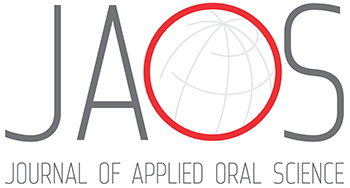Resumo em Inglês:
Abstract Objective: This study aimed to review evidence from randomized controlled trials (RCTs) to describe: 1) the active ingredients and desensitizing toothpaste brands; 2) the evaluation of these active ingredients over time, and 3) the fluoride and abrasive content in the formulations designed to treat dentin hypersensitivity (DH). Methodology: In total, 138 RCTs and their tested toothpastes were included. Searches were updated up to August 19, 2021. Formulations, reported brands, active ingredients over time, and type of fluoride (ionizable or ionic fluoride) and abrasive (calcium or silica-based) were analyzed (PROSPERO #CRD42018086815). Results: Our trials assessed 368 toothpaste formulations, including 34 placebo (9%), 98 control toothpastes with fluoride (27%), and 236 (64%) with active ingredients to treat DH. We tested the following active ingredients: potassium compounds (n=68, 19%), calcium sodium phosphosilicate (CSP) (n=37, 10%), strontium compounds (n=28, 8%), arginine (n=29, 8%), stannous fluoride (SnF2) (n=21, 6%), hydroxyapatite (n=9, 2%), potassium combined with another active ingredient (n=19, 5%), inorganic salt compounds (n=11, 3%), citrate (n=5, 1%), formaldehyde (n=3, 1%), herbal (n=4, 1%), copolymer (n=1, 0.5%), and trichlorophosphate (TCP) (n=1, 0.5%). The number of toothpaste formulations increased since 1968, with the greatest increment after 2010. Most toothpastes described their type of fluoride as sodium monofluorphosphate (MFP) (n=105, 29%) and NaF (n=82, 22%), with silica-based (n=84, 23%) and calcium-based (n=64, 17%) abrasives. Conclusion: Patients and dentists enjoy an increasing number of brands and active ingredients to decide what desensitizing toothpaste to use. The most common types of fluoride are MFP and NaF.
